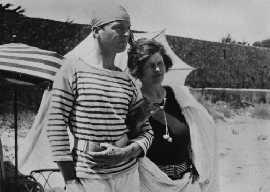
February 01, 2013

The Murpheys at Antibes
Clive James is weak on health but very strong on intellect, and it’s good to read his pithy television criticism for the Telegraph. Clive recently praised Richard E. Grant for pointing out in his program on the Riviera’s history of pictures that not many people nowadays know how good a painter Gerald Murphy was. Murphy was the model for Dick Diver in Fitzgerald’s Tender Is the Night. He was the owner of Mark Cross, a luxury-goods store on 5th Avenue back when luxury goods were beautiful and owned by people with good taste.
Gerald and Sara Murphy invented the summer Riviera of the 1920s. Their Villa America near Antibes was the social center for expatriate American writers, musicians, and artists. Sara was blonde and beautiful and supposedly had an affair with Picasso. I think it was just gossip by those who couldn’t get her into their beds. No matter how much she might have admired Picasso’s crappy art, upper-class American ladies did not sleep with dirty Spanish painters back then—not even now, although there is no more upper class left in America, alas. The new plutocrat poseurs-billionaires pretend to be old money, but they’re crude and still have to think for a split second before picking up their forks and knives.
The Murphys were tragic heroes. They lost both their beautiful sons to sickness and slowly saw their fortune disappear. Gerald Murphy lived in genteel poverty in Easthampton in his late seventies, uncomplaining and a gentleman to the last. Sara died most likely from a broken heart over their lost boys. Gerald burned most of his wonderful paintings, although I think four survived. His was a definite talent, but he never reached the heights of many of his guests because he didn’t really need to. Like the famous Wilde quip, Gerald put his genius into his life and only his talent into his art. He owned a beautiful sailing boat, and Villa America was a dream of a Provençal house filled to the brink with friends. Neither he nor Sara put up with Fitzgerald’s hysterical drunken antics—as when he hit a poor juggler with a fig in Juan-les-Pins—but they always forgave him and remained the tragic writer’s loyal friends until the bitter end.
Can you imagine that, as Grant and James point out, the French Riviera was terra incognita one hundred years ago? It is now a shithole around the coast and only begins to resemble what it once was—an artist’s colony—as one goes up the surrounding verdant hills into Braque and Matisse country. The Italians ruined their side first with unrestricted construction by greedy developers who are a lethal international disease. The French followed after the war. I was lucky to see the old Riviera when fifteen and extremely impressionable. I watched it turn ugly gradually, and I gave it up for good as my summer resort in 1977. During the peak months it is unlivable unless one is up above and ventures sporadically into places such as Nice and Cannes after dark to get into trouble. For the last ten years I’ve been on my boat, and even then peace is hard to come by because of the jet skis and super powerboats that clog up the bays.